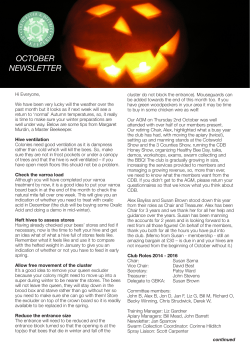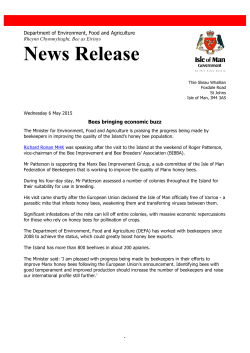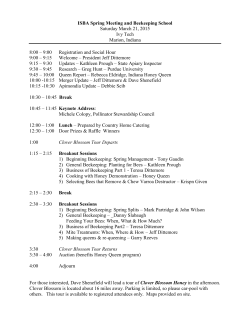
Maximizing Honey Production 2015
Managing Honey Bee Populations for Greater Honey Yield April 2015 We’ll discuss • Introduction • A seasonal approach: – Fall – Spring: Varroa and stimulative feeding – Summer – Winter • An alternative configuration Honey Bees Hoard Honey • The methods and techniques described in this program are intended to support this natural drive • The more methods utilized, the greater the likelihood of producing large populations and honey production • A seasonal approach is used to organize the methods Biology of Honey Production Nectar flow = major nectar producing plants bloom. Bees collect and store nectar converting it to honey. Winter stores for them, surplus for you Basic idea: be prepared to take advantage of available resources and bees’ hoarding instinct June June 1st1st Spring colony expands & prepares for the summer nectar flow Fully expanded colony Hive population and honey production per colony % of bees making honey % of bees covering brood Randy Oliver Bottom line: Going from single deep to double deep means triple number of bees available for honey production Big diversity means big population •Location – location – location •Where you set up your colonies affects quantity and quality of the food they collect We’ll discuss • Introduction • A seasonal approach: – Fall – Spring: Varroa and stimulative feeding – Summer – Winter • An alternative configuration Seasons are circular like a merry-go-round; you can jump in at any point A Seasonal Approach • Fall – Make sure they are strong and healthy – Well provisioned going into winter – Re-queen? Strong & Healthy Bees = Maximum Population = Maximum Honey Yield If the ratio of mites to bees is high in the fall, the bees will suffer and so will honey production Beyond the economic threshold Well provisioned and staying that way: unloading free loaders Honey Stores 80-100 lbs Hive Fall is your last chance to feed syrup to the bees Feed Feed Feed When being fat is a Good Thing Protein Substitute is Necessary to Make Fat Bees Randy Oliver Scientific Beekeeping A young queen is necessary for a strong population and honey production “Young queens prevent swarming better than one year old queens and much better than two year old queens.” George Imerie What, you raise green bees! Fall Requeening Pro Con Timing breaks brood cycle helps reduce pest problems No honey flow = more irritable bees Better mated Hive more populous; harder to find old queen Less expensive More difficult to introduce Faster population build up in later winter/early spring Less time to assess queen’s performance Better availability; no back log Race and Honey Production Italian Source: Glenn Apiaries “Carniolans are known for their explosive, early spring build-up at the first sign of pollen.” Brother Adam Pros Cons •Earlier morning forager •Forages on colder and wetter days than most other bees •Overwinters well on small stores, as queen stops laying in the fall •Explosive build up in early spring •Exceptionally gentle and easy to work •May interrupt brood rearing during times of drought •Does not typically propolize heavily •Creates less brace and burr comb •Crosses well with other varieties •Likely to swarm unless carefully managed (no room to expand) •If pollen is scarce brood rearing greatly diminishes Hubert Tubbs shared that his Russian hives produced 130-150 lbs of honey. This compares to approximately 84 lbs of honey for non-Russians. Pros Cons •Resistant to Varroa Mites •Brood rearing is highly dependent on forage availability •Resistant to Tracheal Mite •Increased tendency to swarm •Quick Spring build up •Tend to propolize •Winter tolerant •More time needed to introduce to non-Russians Note: Russians require different management; they are NOT for beginning beekeepers Winter Keep them dry and well provisioned Stay on top of food stores When do you need to feed? Late Winter Feeding Bees’ reward for being good Winter Insulation Box Insulation Box Screen to hold hay in place Screened ventilation holes Spring When you see Red Current blossoming, it is time to ramp up your population management activity A Seasonal Approach • Spring – Control Varroa – Stimulative feeding – Balance population with growing room – Re-queen – Pyramiding – Reversing – Supering Maintain Varroa below the economic threshold: Do a Varroa Count 1 + _______ 1 2 Much You MUST control Varroa mites! Economic threshold • Point at which the level of infestation is too high • Various ways to determine this – Alcohol wash – Sugar shake – Collection board – For more details go to www.scientificbeekeeping.com Alcohol wash = Gold Standard Goal =Less than5% Sugar Shake 24 hour natural drop Does not give % of infectation Screened bottom board Collection board Collection board for 24 hour natural drop Use hard plastic Draw a counting grid Spray with Pam Slip into slot in screened bottom board Frequency: monthly except winter Notice the 8 legs How are your mite numbers trending? The trend is what is important Early season (March) Less than 10 mites on the collection board in a 24 hour period Watch for false negatives Varroa destructor April Fools Day Don’t be foolish. Start building your population now. Don’t leave them searching for a stimulating meal! Carbohydrate Feeding • 1:1 sugar to water ratio with Honey Bee Healthy added • Mimics the honey flow • Workers feed queen more • Queen responds by laying more eggs Protein Feeding • Simulates a pollen flow • Insures that there is available protein for the colony • Stimulates the bees to feed the queen more • Queen responds by laying more eggs Feed carbohydrate & protein simultaneously to build population BEFORE the nectar flow NOT ON the nectar flow Once you start simulative feeding, you CAN NOT STOP Your Balancing Act When the balancing act is off balance Swarmed Wow! This hive is really congested or maybe it’s just my compound eyes. Look at that swarm! There goes our honey crop. There goes the queen & your future honey Requeening: Swarm Prevention Spring Requeening Pro Con Smaller colonies Interferes with spring build up Less likely to swarm Good mating early in season less likely Easier to introduce More competition to purchase queens Vigorous egg layer = large population for nectar flow Dependent on variable weather Large population going into winter Time to assess queen performance/replace if needed Growing Room: Pyramiding Going from 1 to 2 brood boxes 1. Make space in the center of the new brood box by removing about 3 empty frames 2. Take less than half the brood from the original brood box & place in the space created in new brood box 3. Center remaining brood frames in original brood box & fill the space created on the sides with frames (preferably drawn) removed from the new brood box Pyramiding after adding 2nd brood box Growing Room: Reversing starting with 2 brood boxes BROOD HONEY Reverse Brood Boxes Before After Supering Start supering before the nectar flow Summer Anticipate...Manage colony population...timing! Follow the 70% Rule* When 1st brood box reaches 70%, add a second brood box When the second brood box reaches 70%, add a honey super, etc *60% rule for Russians Drawn comb: worth its weight in gold When you see the Blackberry blossom in early June, the nectar flow has started! Nectar flow in Willamette Valley June 1st June 30th A Seasonal Approach • Summer – Don’t BUG – Checker boarding – Tools of the trade – Supering – Extract Summer Don’t BUG Us When is too much honey not a good thing? The idea behind checker boarding is to perforate the barrier of honey in the super above the brood area Checker Boarding • • • • Manages placement of stored honey Relieves congestion Helps control swarming Contributes to increased honey production Honey Super F = full frame F F F F F F F F E = empty frame F Honey & Brood Less Honey & Brood Brood Brood Before Checker Boarding After Checker Boarding Comparative weight of full boxes 90 80 70 60 50 40 30 20 10 0 Weight 10 frame deep 10 frame medium 8 frame medium Michael Bush “Friends don’t let friends lift heavy supers” Jim Fischer Dave Cushman Tools of the Honey Trade: Imerie Shim Western Dado Cut Imerie Shim Why the Imerie Shim? • Provides upper entrance(s) to the hive. This makes it possible for foragers to gain access to the supers without having to cross a queen excluder (if used). • Upper entrance(s) relieves congestion not only on the landing board but also in the brood area. It provides the field bees a more direct route to the honey area where the nectar is ripened and stored. • Improved ventilation making it easier for the bees to vent the hive of the moisture produced from ripening honey. Imerie Shim Placement Do NOT place Imerie shim directly above the brood box! Continue to follow the 70% Rule* When the second brood box reaches 70%, add a honey super, and keep it up during the nectar flow *60% rule for the Russians Do NOT disturb the brood chamber during the nectar flow! Some medications must be removed before adding a honey super to the hive Now this is successful supering! Extract honey by August 1st • Remove supers • Put boxes in hot dry room • Uncap both sides of frame • Spin honey out w/ extractor 80 - 100 lbs honey for bees Surplus for beekeeper What is honey? What is honey? Bees convert nectar…. – chemically into nectar sugars glucose & fructose – physically into thick consistency with water evaporation C12H22O11 + H2O C6H12O6 + C6H12O6 sucrose + water glucose + fructose Nectar Honey invertase Enzyme invertase chemically converts nectar sugars We’ll discuss • Introduction • A seasonal approach: – Fall – Spring: Varroa and stimulative feeding – Summer – Winter • An alternative configuration The two queen hive: a configuration that maximizes honey production Why a two queen hive? • Two queens exist harmoniously in a single colony • Workers have access to either brood box and honey supers • If 1 queen dies, second queen remains in colony • Each box has its own landing board • MAXIMIZES HONEY PRODUCTION Hive population and honey production per colony % of bees making honey 20% Single deep 60% Double deep Triple deep % of bees covering brood Randy Oliver Bottom line: Going from single deep to double deep means triple number of bees available for honey production “When 2 queens are better than 1” Queen excluder Honey super Honey super Queen #1 Queen #2 Photo: Bee Culture February 2009 Upper entrance Setting up a 2 queen hive • Early May or fall, select a 2 brood box hive to be divided, remove the old queen, make the division and introduce a new queen to each division • Separate the two brood boxes and place them adjacent to each other on the same footprint of the original hive • Place a single queen excluder and at least one honey super over the center of the two brood chambers • Cover the exposed halves of the brood chambers with half sized migratory covers • Add the second brood box to each existing brood box as the population grows maintaining the queen excluder between the top brood boxes and the honey super(s). • Add honey super(s) using the 70% rule Coming full circle back to fall Stored and Stacked “James Bond” Method Don’t Give Varroa a License to Kill! OREGON License to Kill 00753276 Varroa destructor Your Bee Hive Any Place, USA Expires NOW Restrictions Untreated Hives Class K The result of maximizing honey production Glass Jar Beekeeping Bee Culture May 2012 “I have led you to the water now you must decide whether to drink or not.” George Imerie The End Photo: Roger Ledbetter Questions?
© Copyright 2025









